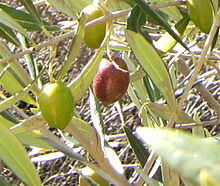Picual
| Picual | |
|---|---|
 Picual olives in Catalonia | |
| Olive (Olea europaea) | |
| Origin | Spain |
| Use | Oil, table |
The Picual is an olive cultivar from Spain. Picual olives are the most commonly grown olive today for olive oil production,[1] with production centered in the Spanish province of Jaén.[2] Picual trees are estimated to account for 25% of all olive oil production in the world.[3][4] Naturally, this varietal is very high in oil content, at 20-27% by weight.[5][1]
Virgin olive oil from Picual olives have high levels of polyphenols (an organic compound which is known to have antioxidant effects),[3] typically between 300 and 700ppm.[4] Many Picual groves are primarily harvested when ripe or overripe to maximize oil content, and thus produce oil with poor taste qualities.[5][1] Less than one quarter of the harvest each year qualifies as Extra Virgin.[5]
References
- ^ a b c Paul M. Vossen (1 January 2007), Organic Olive Production Manual, UCANR Publications, pp. 8–9, ISBN 978-1-60107-440-9, retrieved 22 September 2013
- ^ "Influence of Harvest Date and Crop Yield on the Fatty Acid Composition of Virgin Olive Oils from Cv. Picual" (PDF), Journal of Agricultural and Food Chemistry, 2004, doi:10.1021/jf049894n, PMID 15161211
- ^ a b Aranzazu García; Manuel Brenes; Concepción Romero; Pedro García; Antonio Garrido (2002), "Use of 1-acetoxypinoresinol to authenticate Picual olive oils", International Journal of Food Science & Technology, 37 (6), doi:10.1046/j.1365-2621.2002.00591.x
- ^ a b M. Brenes; A. García; J. J. Rios; P. García; A. Garrido (2002), "Study of phenolic compounds in virgin olive oils of the Picual variety", European Food Research and Technology, 215 (5): 407–412, doi:10.1007/s00217-002-0604-0
- ^ a b c Tom Mueller (5 December 2011), Extra Virginity: The Sublime and Scandalous World of Olive Oil, W. W. Norton, ISBN 978-0-393-08348-4, retrieved 22 September 2013
